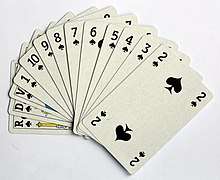Belle, Flux et Trente-et-Un
Belle, Flux et Trente-et-Un, also called Les Trois Jeux or, in German, Dreisatz or Belle, Fluss und Einunddreißig, is an historical, gambling, card game that was widespread in France and Germany during the 17th and 18th centuries. As a relative of Brag and Poch, from which the game of Poker developed, it is of cultural-historical interest. Parlett records it as Best, Flush and Thirty-One.[1]

Rules
The game is played with a pack of 52 French playing cards; in addition three coin dishes are needed for the stakes.
Before the start of the game, each player puts an agreed amount of money into each of the three dishes.
Like Poch, Belle, Flux et Trente-et-Un is a compound game of 3 parts, hence the names Dreisatz ("Triple Set") and Les Trois Jeux ("The Three Games").
Belle
Once the stakes have been placed, each player is dealt 2 cards, face down, and 1 card, face up. The player who has the highest upcard, the so-called Belle, wins the first deal and the contents of the first dish.
The ranking of the cards is as follows (c.f. Écarté):
- King - Queen - Jack - Ace (!) - Ten - Nine - ... - Two
If there is no clear winner, then Forehand, the player who is next to deal, wins.
Flux
In the second deal, Flux (also Fluxus, c.f. flush), the winner is the player who has the highest-value flush. A flush is a hand of three cards of the same suit.
If no player has a flush, the stakes remain in the dish for the next game.
If two or more players have a flush, the card points are added and the highest-value flush wins. For this, the Aces counts as 11 points, the court cards) 10 each, and the pip cards score from 2 to 9 depending on their natural value. If there is a tie, the same rule applies as in Belle: forehand wins.
Unlike the game of Poch, there is no betting on the highest combination, as subsequently became typical for Poker. There is also no option to bluff.
Trente-et-Un
Finally, in the third deal each player attempts, by exchanging cards, to score 31 points, or to get as close to 31 points as possible (c.f. Vingt-et-Un, and the third round of Brag).
The player who comes closest to 31, wins the contents of the third dish. If there is a tie, forehand wins.
The modern casino game of Black Jack was developed from this contract via Trente-et-Un and Vingt-et-Un.
Literature
- Meyers Konversationslexikon of 1888
- Brockhaus Konversationslexikon 1894/96
- Friedrich Anton: Encyklopädie der Spiele, Leipzig, 1889
- Jacques Lacombe: Encyclopédie méthodiques. Dictionnaire des jeux, p. 7 Online, p. 7, at Google Books, 1800
- Parlett, David (1990). The Oxford Guide to Card Games, Oxford University Press, Oxford/New York
- Parlett, David (2008). The Penguin Book of Card Games. Penguin, London
- Parlett 2008, p. 587.